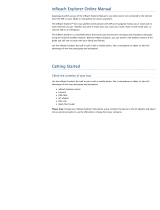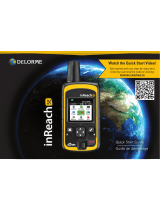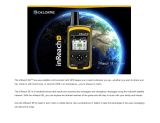
Table of Contents
Getting Started............................................................... 1
Device Overview......................................................................... 1
Mounting and Powering the Device in Your Vehicle................... 1
Turning the Device On or Off...................................................... 1
Acquiring GPS Signals............................................................... 2
Home Screen.............................................................................. 2
Opening an App..................................................................... 2
Adding Shortcuts to the Home Screen.................................. 2
Viewing Notifications.............................................................. 2
Status Bar Icons.....................................................................2
Using the Touchscreen............................................................... 2
Adjusting the Screen Brightness................................................ 2
Vehicle Profiles............................................................... 2
Car Profile................................................................................... 3
Adding a Vehicle Profile..............................................................3
Switching the Vehicle Profile...................................................... 3
Editing a Vehicle Profile.............................................................. 3
Driver Awareness Features and Alerts........................ 3
Enabling or Disabling Audible Driver Alerts................................ 3
Red Light and Speed Cameras.................................................. 3
Street Navigation............................................................ 3
Routes........................................................................................ 3
Starting a Route.......................................................................... 4
Starting a Route by Using the Map........................................ 4
Going Home........................................................................... 4
Editing Your Home Location............................................. 4
Your Route on the Map...............................................................4
Active Lane Guidance............................................................ 4
Viewing Turns and Directions................................................ 4
Viewing the Entire Route on the Map.................................... 5
Arriving at Your Destination........................................................ 5
Parking Near Your Destination.............................................. 5
Changing Your Active Route...................................................... 5
Adding a Location to Your Route........................................... 5
Shaping Your Route...............................................................5
Taking a Detour..................................................................... 5
Changing the Route Calculation Mode.................................. 5
Stopping the Route..................................................................... 5
Using Suggested Routes............................................................ 5
Avoiding Delays, Tolls, and Areas.............................................. 5
Avoiding Traffic Delays on Your Route.................................. 5
Avoiding Toll Roads............................................................... 6
Avoiding Toll Stickers.............................................................6
Avoiding Road Features........................................................ 6
Avoiding Environmental Zones.............................................. 6
Custom Avoidances............................................................... 6
Avoiding a Road................................................................ 6
Avoiding an Area............................................................... 6
Disabling a Custom Avoidance......................................... 6
Deleting Custom Avoidances............................................ 6
Finding and Saving Locations...................................... 6
Points of Interest......................................................................... 6
Navigating to a Garmin Explore Location.............................. 7
Finding a Location by Category............................................. 7
Searching Within a Category............................................ 7
Finding Campgrounds............................................................7
Finding RV Parks.............................................................. 7
Finding Ultimate Campgrounds Points of Interest................. 7
Finding RV Services.............................................................. 7
Finding National Parks........................................................... 7
Exploring National Park Features and Amenities............. 7
Finding iOverlander™ Points of Interest................................ 7
Finding HISTORY® Points of Interest................................... 7
Foursquare
.............................................................................7
Searching Foursquare Points of Interest.......................... 7
TripAdvisor®.......................................................................... 8
Finding TripAdvisor Points of Interest............................... 8
Navigating to Points of Interest Within a Venue.................... 8
Exploring a Venue............................................................. 8
Finding a Location Using the Search Bar................................... 8
Finding an Address..................................................................... 8
Location Search Results............................................................. 8
Location Search Results on the Map..................................... 8
Changing the Search Area......................................................... 9
Custom Points of Interest........................................................... 9
Installing POI Loader............................................................. 9
Finding Custom POIs............................................................. 9
Parking........................................................................................9
Finding Parking Near Your Current Location......................... 9
Understanding Parking Colors and Symbols......................... 9
Search Tools...............................................................................9
Finding an Intersection...........................................................9
Finding a City......................................................................... 9
Finding a Location Using Coordinates................................... 9
Viewing Recently Found Locations............................................ 9
Clearing the List of Recently Found Locations...................... 9
Viewing Current Location Information........................................ 9
Finding Emergency Services and Fuel.................................. 9
Getting Directions to Your Current Location........................ 10
Adding a Shortcut..................................................................... 10
Removing a Shortcut........................................................... 10
Saving Locations...................................................................... 10
Saving a Location................................................................ 10
Saving Your Current Location.............................................. 10
Editing a Saved Location..................................................... 10
Assigning Categories to a Saved Location.......................... 10
Deleting a Saved Location................................................... 10
Using the Street Map.................................................... 10
Map Tools................................................................................. 10
Viewing a Map Tool............................................................. 10
Up Ahead.................................................................................. 11
Viewing Upcoming Locations............................................... 11
Customizing the Up Ahead Categories................................ 11
Warning and Alert Symbols...................................................... 11
Restriction Warnings............................................................ 11
Road Condition Warnings.................................................... 11
Alerts.................................................................................... 11
Trip Information.........................................................................11
Viewing Trip Data from the Map.......................................... 11
Customizing the Trip Data Fields.................................... 11
Viewing the Trip Information Page....................................... 11
Viewing the Trip Log............................................................ 11
Resetting Trip Information....................................................11
Viewing Upcoming Traffic......................................................... 11
Viewing Traffic on the Map.................................................. 12
Searching for Traffic Incidents............................................. 12
Customizing the Map................................................................ 12
Customizing the Map Layers............................................... 12
Changing the Map Data Field.............................................. 12
Changing the Map Perspective............................................ 12
Off-Road Navigation..................................................... 12
Garmin Explore......................................................................... 12
Logging In to a Garmin Explore Account............................. 12
Map...................................................................................... 12
Downloading Garmin Explore Maps................................12
Filtering Map Data........................................................... 13
Garmin Explore Map Settings......................................... 13
Creating a Waypoint........................................................13
Creating a Route............................................................. 13
Table of Contents i


























